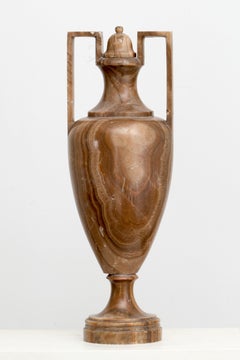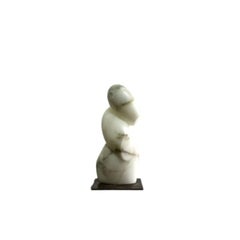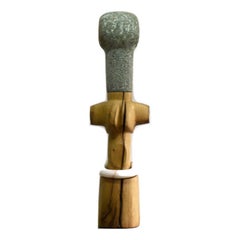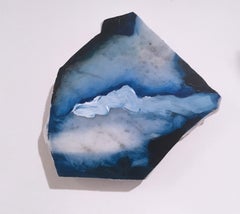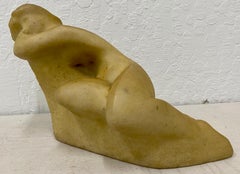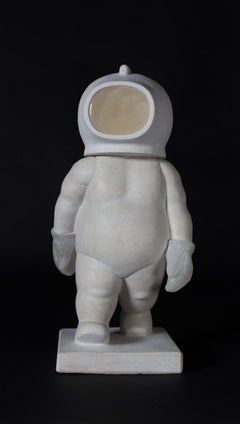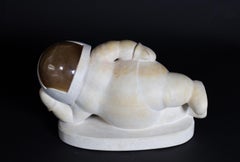Alabaster More Art
to
3
1
1
1
Overall Height
to
Overall Width
to
2
1
1
1
1
2
2
3,123
7,680
4,715
3,580
3,104
Medium: Alabaster
MONUMENTAL NEOCLASSICAL URN IN ALABASTER -Italy, 19th Century Alabastro fiorito
Located in Milan, IT
MONUMENTAL NEOCLASSICAL URN IN ALABASTER
Italy, 19th Century
Alabastro fiorito
54 x 18 cm
21 1/4 x 7 in
minor chips and damages
Category
19th Century Alabaster More Art
Materials
Alabaster
Yann Barrere - Intro - Original Sculpture
Located in Collonge Bellerive, Geneve, CH
Yann Barrere - Intro - Original Sculpture
Dimensions: 41 x 23 x 16 cm
Materials: Alabaster
"For me, the pleasure of sculpture is already that of pruning. It is a matter of physical ...
Category
2010s Modern Alabaster More Art
Materials
Alabaster
Yann Barrere - Akua’ba - Original Sculpture
Located in Collonge Bellerive, Geneve, CH
Yann Barrere - Akua’ba - Original Sculpture
Dimensions: 82 x 23 x 16 cm
Materials: Brazilian mica-fuschite, Alabaster
"For me, the pleasure of sculpture is al...
Category
2010s Modern Alabaster More Art
Materials
Alabaster
Related Items
Untitled "Marble Fragment 3" 2019, acrylic, landscape, wall sculpture, clouds
Located in Jersey City, NJ
Untitled "Marble Fragment 3" 2019, acrylic, landscape, wall sculpture, clouds, purple, blue
Category
2010s Contemporary Alabaster More Art
Materials
Marble
H 7 in W 7 in D 0.75 in
Vincent Glinsky Alabaster Reclining Nude Sculpture c.1950
Located in San Francisco, CA
Vincent Glinsky Alabaster Reclining Nude Sculpture c.1950
9" long x 4.5" deep x 7.5" high
Signed at the base
Good vintage condition
Vincent Glins...
Category
Mid-20th Century Art Deco Alabaster More Art
Materials
Alabaster
H 7.5 in W 9 in D 4.5 in
Sculpture Portrait Bust Of Dante Alighieri Italian White Alabaster Grand Tour
Located in Roma, IT
a portrait bust in alabaster marble of the "Sommo Poeta" Dante Alighieri universally knew as the father of the Italian Language and one of the most important Italian writer poet and ...
Category
Early 20th Century Other Art Style Alabaster More Art
Materials
Alabaster
H 9.06 in W 4.73 in D 2.37 in
Vintage French Modernist Jean Lurcat Glazed Ceramic Art Plate Sant-Vicens France
By Jean Lurçat
Located in Surfside, FL
Vintage Jean Lurcat glazed fired enamel wall plaque ceramic plate limited edition hand inscribed faience Ceramique Saint Vicens charger. It depicts hig...
Category
Mid-20th Century Modern Alabaster More Art
Materials
Ceramic, Glaze
En Face, Mica and Steel Woven Wall Hanging and Installation, Agneta Hobin
By Agneta Hobin
Located in Wilton, CT
En Face, Agneta Hobin, mica and steel, 70" x 48", 2007.
This 7-piece mica and steel hanging installation and sculpture is by Finnish artist, Agneta Hobin...
Category
Early 2000s Contemporary Alabaster More Art
Materials
Steel
1950's Organic Modern Ceramic Turquoise Abstract Sculpture / Pottery Art Vase
Located in Soquel, CA
Gorgeous abstract ceramic sculptural vase shaped into a unique organic yet modern form, with turquoise and earth-toned glazes that naturally blend together an catch the light at diff...
Category
Mid-20th Century Modern Alabaster More Art
Materials
Clay, Glaze
Early 20th C Alabaster Sculpture of a Seated Female Bather.
Located in San Antonio, TX
Early 20th C Italian Art Nouveau Alabaster Sculpture of a young female bather. Bather is seated on a stone with arms crossed in a mode...
Category
Early 20th Century Art Nouveau Alabaster More Art
Materials
Alabaster
Free Shipping
H 15 in W 8.5 in D 7.5 in
Vintage French Modernist Jean Lurcat Glazed Ceramic Art Plate Sant-Vicens France
By Jean Lurçat
Located in Surfside, FL
Vintage Jean Lurcat glazed fired enamel wall plaque ceramic plate limited edition hand inscribed faience Ceramique Saint Vicens charger. It depicts a h...
Category
Mid-20th Century Modern Alabaster More Art
Materials
Ceramic, Glaze
Vintage French Modernist Jean Lurcat Glazed Ceramic Art Plate Sant-Vicens France
By Jean Lurçat
Located in Surfside, FL
Vintage Jean Lurcat glazed fired enamel wall plaque ceramic plate limited edition hand inscribed faience Ceramique Saint Vicens charger. It depicts a h...
Category
Mid-20th Century Modern Alabaster More Art
Materials
Ceramic, Glaze
Glow - Fan , Woven mica and bronze wall sculpture by Agneta Hobin
By Agneta Hobin
Located in Wilton, CT
Agneta Hobin of Finland is best known for impressive works in which yellow mica has been woven into metal warp; the technique and materials are the artist...
Category
Early 2000s Contemporary Alabaster More Art
Materials
Bronze
H 18 in W 27 in D 2.5 in
Marco, Mid-Century Polish Tapestry by Zofia Butrymowicz
Located in Wilton, CT
Zofia Butrymowicz (1904-1987, Warsaw, Poland) was one in a select group of Polish textile artists who were first introduced in Chicago, USA in the 1970s by legendary dealers Anne and Jacques Baruch. Butrymowicz's body of work continues to influence the fiber art world to this day.
"New experiments in art have always been of interest to me" Butrymowicz once observed, "whether I agree with them or not, and therefore I never pass by and I am never indignant at any expression in art. I strongly believe that in the wide range of experiments there will also be some elements of the development of culture."
During the post-war period, when the countries of Eastern Europe were locked down behind the Iron Curtain, weavers there found materials in short supply. As a result, many of these artists turned to unconventional materials such as metal, paper and reeds. Zofia Butrymowicz, of Poland, recognized for innovative works in 60s and 70s, used heavy, irregular wools, barely spun at all. In 1969, she visited Canadian weaver, Mariette Rousseau-Vermette and her husband, painter and ceramicist, Claude Vermette, outside Montreal where the couple lived and worked. Zofia and Mariette had both been participants in International Tapestry Biennials in Lausane, Switzerland in the 60s and in Wall Hangings at the MoMA in New York in 1969.
Butrymowicz stayed with the Vermettes for several months, using Mariette’s looms to create tapestries that were displayed with Claude’s ceramics at a local gallery. Butrymowicz used wool from Mariette’s source. Mariette was particular about the color and intensity of her wool — she worked with technicians to perfect the spinning and dyeing so that the wool had a silky luster and dyed “more beautifully” than mechanically spun wool. The wool was a marked departure from the material Butrymowicz had access to in Poland. She “painted” her weavings with colors and shadings of yarns, including only a shimmering suggestion of a shape, often a circle, as she had done in the past, but the glisten and sumptuousness of the yarn in these works set them apart from her previous weavings.
Selected exhibitions: Central Museum of Textiles, Lodz, Poland; Museum of Contemporary Art, Chicago, Illinois; National Museum, Poznan, Poland; National Museum, Warsaw, Poland; Skopje Museum of Contemporary Art, Poland; Exempla, Munich, Germany; Museum of Modern Art, Pasadena, California; Pierre Pauli...
Category
1960s Modern Alabaster More Art
Materials
Fabric, Textile, Tapestry, Wool
H 37 in W 34 in D 0.5 in
Pair of Italian "Alabaster Stone Lions" after Antonio Canova; Mid 19th Century
Located in SANTA FE, NM
"Pair Recumbent Stone Lions"
after Antonio Canova (1757-1822)
Italian (possibly Florence)
Mid 19th Century
Alabaster, marble
6 x 9 x 4 inches
This is an exquisite pair of Italian alabaster lions on marble bases based on the monumental lions carved by Antonio Canova (1757-1822), the greatest Italian neoclassical sculptor. Canova sculpted the marble lions for the monumental tomb of Pope Clement XIII in St. Peter’s, Rome in 1792
Canova Lions refers to the pair of copies of lion sculptures by Antonio Canova. When Canova created the sculptures in 1792, he installed them on the tomb of Pope Clement XIII. The marble sculptures are some of the most prominent features in St. Peter's Basilica in Rome. Given the intricacies of creating the original Canova lions, some artists created molds and replicated them. A good example is the pair of lion sculptures...
Category
1850s Italian School Alabaster More Art
Materials
Alabaster, Marble
Previously Available Items
Figurative Marble Sculpture Mario Romero New Age Explorers The walker
Located in Segovia, ES
"The walker, explorer No. 14" by Spanish artist Mario Romero Fernández
Technique: Sculpted stone.
Material: Alabaster and Cream marble.
Measur...
Category
2010s Contemporary Alabaster More Art
Materials
Alabaster, Marble
H 16.15 in W 7.88 in D 6.3 in
New Age Explores. Nº 6 Venus. Figurative Marble Sculpture by Mario Romero
Located in Segovia, ES
New Age Explores. Nº 6 Venus. Figurative Marble Sculpture by Mario Romero
Technique: Sculpted stone
Material: Alabaster and Cream marble.
Measures: 22 H ...
Category
2010s Contemporary Alabaster More Art
Materials
Alabaster, Marble
H 8.67 in W 14.57 in D 7.49 in
Granite Barriers (Near Colorado Springs/Manitou Colorado)
Located in Denver, CO
Oil on artist board. Housed in a custom hand-carved gold leaf frame; outer dimensions measure 18.25 x 22.25. Image measures 12 x 16 inches.
Expedited and International Shipping is Available; please contact us for an estimate.
Provenance:
Estate of the Artist
About the Artist:
As a young child in Sweden, John F. Carlson was introduced to art by an uncle who decorated carriages with landscapes. At the age of twelve, Carlson moved with his family to the United States and settled in Buffalo, New York.
Carlson's early interest in art grew and he apprenticed with a lithographer and received guidance from an amateur artist named Frederick Mayor. He later worked as a Lithographer at Cosack & Company to help support his family. His formal training began at the Albright School of Art (Albright Art Gallery) where he studied under Lucius Hitchcock. In 1902, Carlson earned a scholarship to the Art Students League in New York where he was a pupil of Frank Vincent DuMond.
Following his two years of study at the Art Student's League, Carlson went to Woodstock, New York, with a scholarship to study at Byrdcliffe, a fledgling art colony (later known as the Woodstock Artists Association). He received instruction from Birge Harrison, a Tonalist, who became both a mentor and a friend to the young artist. In 1906, Carlson, who was then a member of the Art Students League's Board of Control, was instrumental in the decision to move the League's summer school from Connecticut to Woodstock. Birge Harrison was named director of the new school of landscape at Woodstock and he hired Carlson as his assistant. Carlson became the school's director following Harrison's retirement in 1911, hiring Frank Swift Chase as his assistant. By that time, there were over one hundred students studying at the school. Enrollment was at its greatest under Carlson's directorship which lasted until his resignation in 1918.
In June of 1920, Carlson and his family moved to Colorado Springs...
Category
1920s Other Art Style Alabaster More Art
Materials
Alabaster
H 18.25 in W 22.25 in D 1.5 in
Oil No. 9
By Raymond Jonson
Located in Denver, CO
Framed dimensions measure 23.5 x 31.5 inches.
Expedited and International Shipping available; please contact us for a quote.
About the artist:
Seeking the spiritual in art, Raymond Jonson developed an abstract style of painting that was unique in pre-1940s New Mexico. While his colleagues in the Transcendentalist Painting Group similarly shared his interest in the metaphysical, Jonson alone found his means in a non-objective relationship of forms. Strongly influenced by Kandinsky, the painter moved from stylized representations of nature to formalist expressions of universal harmony. In order to achieve his aims, he became a master of materials, known for his meticulous working methods.
Born in Iowa, Jonson spent his early years moving around the country with his family, necessitated by his minister father's work. They finally settled in Portland, Oregon, in 1902, and this same year Raymond had a spiritual experience in which he sensed the presence of God. When his family's Baptist faith disappointed him, he transposed this feeling to art, to which he committed his life. When the Portland Art Association established its Museum Art School, Jonson enrolled as its first student.
His dedication led him to Chicago to study at the Academy of Fine Arts, a very good commercial school, which afforded a strong grounding in drawing. Here he met B.J.O. Nordfedlt, a Swedish immigrant, who introduced the younger Jonson to the colorist experimentation of the Fauves. The Arthur Dove exhibition and the Armory Show brought to Chicago both expanded his awareness of the emotive possibilities of modernist art movements.
From 1912 to 1917, Jonson was lighting, stage set, costume, and graphics designer for the Chicago Little Theater, America's first experimental theater. Among their bold departures was a minimalist aesthetic, which reduced the stage elements and enhanced the dramatic content with light. Devising the 9-switch dimmer board, Jonson (going by C. Raymond Johnson) became an international theater figure. He also met his wife, Vera White, secretary for the theater and poet.
On a trip to the Colorado Rockies in 1917, Jonson was moved by the power of this sublime landscape and its clarity of light. He began to consider how paint could express light -- material into immaterial. Teaching at the Chicago Art Institute, he was able to get away to the MacDowell Art Colony in 1919, and his elevated sensibilities increasingly perceived the oppressive side of city life. Believing the aim of life was toward harmony, Jonson placed new emphasis on design as a unifying principle. Reading Kandinsky's "The Art of Spiritual Harmony" further convinced him that the mission of art was to make this harmony visible.
In 1922, he spent the entire summer in Santa Fe, and his experience there filtered into his work upon returning to Chicago. When his mother supplied the money for a studio, he moved to New Mexico in 1924, building his home across the street from his friend Nordfeldt. Jonson pursued the concept of order as found in "simple basic motives of spaces and interesting variety of shapes and spaces, a balance of line direction."
In the work of the late 20s, he submits natural forms, such as mesas and even the Grand Canyon, to a dynamic patterning in which the quality of light becomes a design element. Significantly, Jonson thought that emotion could be included by creating juxtaposed rhythms within the composition. Influenced by Indian design, these paintings recall Art Deco ornamentation in the combination of organic and geometric motifs and the electric color effects.
Taking the next leap, Jonson set about purifying his work of all representation. Beginning in the thirties, he explored new ways applications of color and tonality to suggest the quality of transparency, which created the sense of different planes within one surface. Philosophically, this transparency was the artistic means to "expose the spirit of man." Carefully painting gradations, he achieved luminosity and, with colors close to each other, vibration. He eventually used an airbrush for further ethereal effects. Rather than suggest the metaphysical with subject matter, Jonson proposed an approach to painting which de-materialized the actual physical object. In 1938, he and Emil Bisttram were the core of the Transcendentalist Painters Group, which advanced these principles among other artists in Santa Fe and Taos.
As advocate and impresario, Jonson casts a long shadow. Although there was strong sentiment against it, he organized the modern wing of the Museum of New Mexico. In 1934, he painted six murals for the University of New Mexico, which began his relationship with the Albuquerque institution. For many years, he commuted there from Santa Fe but in 1950 he moved there to the gallery/studio provided. Upon his retirement in 1954, he continued to stage exhibitions, thus making the gallery a citadel of modernism in the Southwest. The building itself is a landmark of Pueblo Revival...
Category
1950s Abstract Expressionist Alabaster More Art
Materials
Alabaster
Alabaster more art for sale on 1stDibs.
Find a wide variety of authentic Alabaster more art available on 1stDibs. While artists have worked in this medium across a range of time periods, art made with this material during the 21st Century is especially popular. There are many well-known artists whose body of work includes ceramic sculptures. Popular artists on 1stDibs associated with pieces like this include Yann Barrerre, and Mario Romero Fernández. Frequently made by artists working in the Modern, Contemporary, all of these pieces for sale are unique and many will draw the attention of guests in your home. Not every interior allows for large Alabaster more art, so small editions measuring 0.1 inches across are also available Prices for more art made by famous or emerging artists can differ depending on medium, time period and other attributes. On 1stDibs, the price for these items starts at $1 and tops out at $929,058, while the average work can sell for $1,099.
Recently Viewed
View AllMore Ways To Browse
Blender Vintage
Robert Susan
American Bureau
Large Black Wood Wall Sculpture
Fauve Style Paintings
Early American Art Primitive
Used Doors Philadelphia
Italian Male Paintings
Picasso Flower
Tiffany Century City
Men Marines
Maurice Man
Renaissance Flower Painting
Japanese Food Art
Haring Dance
Up Junior
Oriental Dress
Old Master Painting Bird
